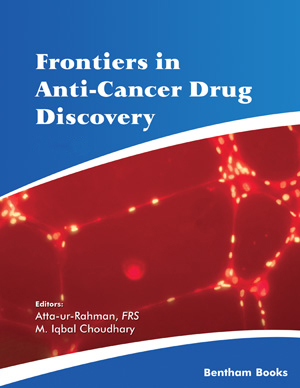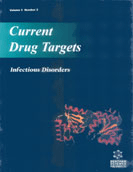Book Volume 12
Preface
Page: i-ii (2)
Author: Atta ur-Rahman and M. Iqbal Choudhary
DOI: 10.2174/9789811487385121120001
List of Contributors
Page: iii-iii (1)
Author: Atta ur-Rahman and M. Iqbal Choudhary
DOI: 10.2174/9789811487385121120002
Cannabinoid-based Anti-cancer Strategies: Slowly Approaching the Bedside
Page: 1-36 (36)
Author: Paula Morales* and Nadine Jagerovic*
DOI: 10.2174/9789811487385121120003
Abstract
Modulation of the endocannabinoid system has emerged as a potential therapeutic strategy for the treatment of diverse types of cancer and related pathologies. Thus far, the use of specific cannabinoids has been primarily approved for the management of chemotherapy-induced side effects. Palliative actions of cannabinoids include the control of nausea and vomiting, pain alleviation and appetite stimulation. Moreover, a growing body of research has exposed the anticarcinogenic potential of cannabinoids. In vitro and in vivo studies have shown that endogenous, plant-derived and synthetic cannabinoids can effectively modulate tumor growth in diverse cancer models. Although this has not yet reached the bedside, ongoing clinical trials and research efforts may approach cannabinoid-based antitumor therapies to cancer patients in the near future.
So far, studies on cannabinoids as antitumor agents have been mainly focused on understanding the mechanism of action of well-known phytocannabinoids such as Δ9-THC or CBD. However, novel cannabinoids with antitumor properties are also emerging in the literature. In this chapter, we aim to provide an updated overview of the therapeutic potential of cannabinoids in cancer. We will comprehensively summarize the diverse cannabinoid structures exerting antitumor properties analyzing the molecular basis of these actions. Recent and ongoing clinical trials will be considered to provide a deeper insight into the current scenario of cannabinoids in oncology.
The Beneficial Effects of Turmeric and its Active Constituent in Cancer Treatment: Current and Future Trends
Page: 37-67 (31)
Author: Giftson J. Senapathy, Blassan P. George and Heidi Abrahamse*
DOI: 10.2174/9789811487385121120004
PDF Price: $15
Abstract
‘Turmeric’ (Curcuma longa L.) is an important spice found almost in every culinary preparation of Asian cooking, especially in India. This yellow rhizome is known for its medicinal and nutritional properties for many centuries and hence in Chinese and Indian traditional medicine it has been used for treating internal diseases and common ailments. It has various pharmacological properties including anticancer activity, which is mainly centered on its orange colored curcuminoid polyphenol called “curcumin”. Cancer is a deadly multifactorial disease originating from cells affecting many parts of the body in later stages. New cancer drugs and treatment methods become an everyday search due to the genetic complexity of the disease. Nowadays, natural products like turmeric are gaining importance as cancer therapeutics since their dietary intake reduces the cancer risk. In this chapter, the background, importance and pharmacological activities of turmeric and its chemical constituent curcumin were discussed with reference to the recent anticancer studies. Numerous reports are available on the anticancer potential of turmeric and curcumin. As reflected from these study results, curcumin was observed to inhibit the proliferation of cells, invasion, angiogenesis and metastasis in tumor cells. It increases the accumulation of free radicals through the reactive oxygen species resulting in apoptosis. It also sensitizes cancer cells for other cancer therapies. Due to its antioxidant and pharmacological activities, it can even reverse the cancer progression in the early stages. In contrast, the poor absorption limits its clinical use but the conversion into nanoforms improves its solubility. Curcumin is nongenotoxic and nonmutagenic and hence it is approved as a safe substance in various clinical trials.
Immunotherapy Approaches Focusing on Cancer Stem Cells
Page: 68-100 (33)
Author: Marcela Rodrigues de Camargo*, Rafael Carneiro Ortiz, Carolina Mendonça Gorgulho, Vanessa Soares Lara and Camila Oliveira Rodini
DOI: 10.2174/9789811487385121120005
PDF Price: $15
Abstract
Metastasis and relapses are still one of the main causes of death in many cancer patients, and they probably occur since cytotoxic chemotherapy as well as the the stress from surgery itself can impair the steady immunological state, the ability to develop an antitumor immune response and also because of poor cancer stem cells (CSC) elimination. CSC appear to use features of both cancer cells and stem cells, including self-renewal and resistance to apoptosis for survival and proliferation, making cancer elimination even more difficult, which then becomes a potential therapeutic target. In this scenario, the successful generation of immunity is the key that can help fight against cancer. Techniques such as monoclonal antibodies, dendritic cell vaccine, and adoptive T cell therapies have been developed, targeting CSC to eliminate tumor mass. In this chapter, some features and aspects of CSC, as well as their relation with patients’ prognosis and therapeutic values, will be listed.
Immunotherapy for the Treatment of Hepatocellular Carcinoma
Page: 101-140 (40)
Author: Stepan M. Esagian, Ioannis A. Ziogas and Georgios Tsoulfas*
DOI: 10.2174/9789811487385121120006
PDF Price: $15
Abstract
This chapter will present the most recent advances in the management of hepatocellular carcinoma (HCC) with immune checkpoint inhibitors (ICIs). Immunotherapy is a rapidly developing and promising field of cancer treatment with many applications, including HCC. In this chapter, we will explain the rationale behind the use of ICIs in the management of HCC by highlighting their molecular mechanisms of action and interactions with the tumor microenvironment. We will also present the most recent data for their safety and efficacy in the resectable, unresectable and posttransplantation setting. Furthermore, we will assess their current status according to the most recent HCC management guidelines and how they compare with other available treatments. The proposed synergy of ICIs with other molecular targeted agents, such as vascular endothelial growth factor inhibitors, will also be analyzed. Finally, we will discuss the current limitations and challenges of ICIs and explore future research perspectives that may solidify their role as a standard HCC therapeutic option, in an era of personalized cancer treatment.
Role of Biomarkers in Developing Therapies for Glioblastoma Multiforme
Page: 141-163 (23)
Author: Vijeta Prakash and Reema Gabrani*
DOI: 10.2174/9789811487385121120007
PDF Price: $15
Abstract
Brain and nervous system cancer account for 28,142 new cases as of GLOBOCAN 2018. Glioblastoma multiforme (GBM) is a quite lethal and aggressive form of tumor which initiates from the cerebrum glial cells. Additionally, due to its aggressive nature of the infection, it is ranked as grade IV of astrocytoma by WHO and accounts for the most malignant cases of gliomas. The current standard of care includes surgical elimination of the tumor followed by radiotherapy and temozolomide (TMZ). The recent research focuses to identify its novel biomarkers as therapeutic targets. Currently, available drugs can be potentiated with adjuvant therapy. These include the inculcation of immunotherapy, phytochemicals, and chemotherapy. However, due to the tumor heterogeneity in GBM, there is a development of resistance majorly against the chemotherapeutic drugs. The most significant reason behind this is alteration and mutation in molecular pathways involved in functions like angiogenesis, migration, proliferation, and several other events. Therefore, moving towards personalized medicine, identification and characterization of biomarkers can promote prediction, diagnosis as well as treatment. Several biomarkers in molecular as well as metabolic pathways such as methylguanine-DNA methyltransferase (MGMT), receptor tyrosine kinase (RTK) pathways, TP53/MDM2/P14 and isocitrate dehydrogenase (IDH) for GBM have been identified. Apart from these, there are miRNA, GBM cancer stem cells (GSCs), and immune checkpoints, which can be used as biomarkers. This chapter reviews the research and progress of the biomarkers as an aid for GBM therapeutics.
Poly (ADP-Ribose) Polymerases as New Drug Targets in Cancer Treatment
Page: 164-195 (32)
Author: Fatih Tok* and Bedia Koçyiğit-Kaymakçıoğlu
DOI: 10.2174/9789811487385121120008
PDF Price: $15
Abstract
Cancer is the second leading cause of death worldwide, remains one of the most major health problems worldwide. Chemotherapeutic agents play an important role in cancer therapy. However, many anticancer drugs have potential disadvantages, such as non-selective toxicity, few drug targets, higher medical costs. Furthermore, since rapid resistance to chemotherapeutics, medicinal chemists aim to develop new anticancer drugs with better properties. The development of new anticancer drugs is one of the most vital areas of research in chemical science. Poly (ADP-ribose) polymerase (PARP) is an important nuclear enzyme responsible for the genomic repair, telomerase regulation, transcription, and regulation of cell death. Poli (ADP-ribose) polymerase inhibitors have recently been approved for cancer treatment, especially breast and ovarian cancer. In this study, we explained the roles of PARP inhibitors in cancer treatment and their mechanisms of action with their structure-activity relationship. Therefore, this article will provide readers with a new perspective on cancer diseases and its treatment with PARP inhibitors.
Subject Index
Page: 196-204 (9)
Author: Atta ur-Rahman and M. Iqbal Choudhary
DOI: 10.2174/9789811487385121120009
Introduction
Frontiers in Anti-Cancer Drug Discovery is a book series devoted to publishing the latest advances in anti-cancer drug design and discovery. In each volume, eminent scientists contribute reviews relevant to all areas of rational drug design and drug discovery including medicinal chemistry, in-silico drug design, combinatorial chemistry, high-throughput screening, drug targets, recent important patents, and structure-activity relationships. The book series should prove to be of interest to all pharmaceutical scientists involved in research in anti-cancer drug design and discovery. The book series is essential reading to all scientists involved in drug design and discovery who wish to keep abreast of rapid and important developments in the field. This volume of the series focuses on reviews of treatments derived from natural sources (cannabinoid-based medicines and turmeric), immunotherapy, biomarkers for glioblastoma and some new drug targets for anti-cancer treatment. The reviews included in this volume are: - Cannabinoid-Based Anticancer Strategies: - The Beneficial Effects of Turmeric and Its Active Constituent in Cancer Treatment - Immunotherapy Approaches Focusing on Cancer Stem Cells - Immunotherapy for the Treatment of Hepatocellular Carcinoma - Role of Biomarkers in Developing Therapies for Glioblastoma Multiforme - Poly (ADP-ribose) Polymerases as New Drug Targets in Cancer Treatment






















